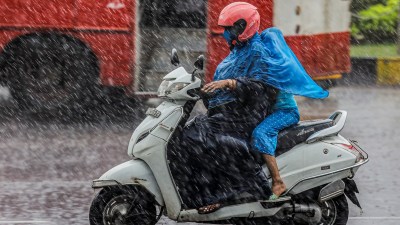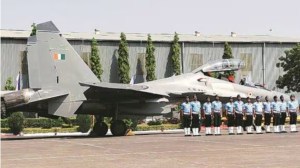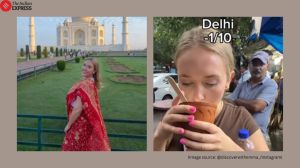HIGHWAY to heaven
The first car rally on J&Ks majestic Mughal road leaves a heady aftertaste
The first car rally on J&Ks majestic Mughal road leaves a heady aftertaste
Thunder,lightning and then a heavy downpour. This was the worst possible weather for a car rally criss-crossing the difficult terrain of the Himalayas. That too a rally on the 400-year-old Mughal roadstretching for 84 km from Bafliaz in Jammu and Kashmirs Poonch district to Shopian in Pulwama district.
This was no ordinary road. A few hundred years ago,it had nothing less than royalty traversing it. Mughal emperor Akbar is said to have marched his troops on this road when he conquered Kashmir in 1586. Jahangir died on this stretch,while on his way back from Lahore. It was once Kashmirs only link to the outside world. It had been abandoned to the elements for over half a century,and since then was used only by the nomadic Gujjar and Bakerwal tribesmen. And here we were,dragging it back to real time.
We were marshals assigned to the first car rally on the Mughal roadalso the first rally to start and end in Jammu and Kashmir given the task of timing the participants.
In the pouring rain,the deserted road ahead looked difficult. But wireless sets soon crackled to life in our convoy. As we crossed Srinagar in the early morning and rode into the interior stretches in Kokernag,we were greeted by the sight of CRPF men holding up umbrellas. Inside the car,organisers from the Himalayan Motorsport Association,kept up a warm chatter over the wireless sets on everything from Kokernags famed trout farm to the latest on army checkposts.
As we clocked the miles,the lush greenery receded and the snow-capped mountains inched closer. The rain slowed to a drizzle but it was colder than ever. We were approaching Sinthan Pass en route to Bafliaz,our post at a height of 12,500 feet.
By 7 in the morning,we had taken up positions. We were not the only ones there. The chief minister had also decided to fly down in a chopper for the showpiece rally; officials were a worried lot. Surely,in front of us was one of the worlds highest traffic jams,right in the upper reaches of the Valley.
But the chopper was unable to land because of bad weather and the crowd thinned out gradually. Soon enough,our work began. The boom of racing motor engines silenced the rest of the crowd.
The rally cars whizzed past,and it was obvious from the excitement among the security personnel that they had never seen the mad thrill of racing on these mountain reaches. After the last rally car had gone off in a splash of mud and tyre marks,the guards who were now off duty chatted with us. Over steaming chai,at a perfect little tea shop,we swapped stories before heading back to Srinagar.
For the second leg of the rally,we reached Shopian the next morning. You are halfway to heaven and we built the road,announced a sign by a construction company. The sign was right.
We drove along narrow stretches of road surrounded by tall chinar trees and the mountain air was heady. But it was not all nature and beauty,bulldozers and cement mixers were also soon in view,dotting the road at regular intervals. The Mughal road,the shortest link between the border districts of Poonch,Rajouri and Srinagar,has long been in a work-in-progress mode. It was supposed to be opened to traffic in May this year. But it will be another two years before work is completed.
Our post was at Lal Gulam,a little below Pir Ki Gali,about halfway along the Mughal Road. Row upon row of the majestic chinar and deodar trees merged with small streams; wisps of cloud threw shadows across the mountains,it was picture perfect. Just when we thought there could be no sign of life ahead on the mountain side,we saw horses grazing nonchalantly high up on mountain side,next to a lonely house.
There were a fair number of Mughal monuments up this road. Chingus in Rajouri district is home to a fort where the remains of emperor Jahangir were kept before his burial in Lahore. Rest houses at Sukh Sarai,Khampur,Thana Mandi lie in various stages of neglect. The picturesque Noori Chamb falls at Behramgala,named by Jahangir after Queen Noor Jahan,and the confluence of the Thatta Pani and Parnai streams are waiting for a new lease of the life at the hands of the Mughal road project.
It was about 10.30 a.m when the first rally car,a white gypsy,hurtled across the hair pin bend and we read out the GPS readings for the cars,helped along by warning shouts from workers a little ahead of us.
Soon,cars were jostling for space on the narrow track,ready for the final burst of adrenaline. Sunny Sidhu,35,a veteran on the rally circuit who had earlier won both Raid De Himalaya and the Desert Storm,was the winner.
Sidhu told us about how he almost didnt win this rally. My engine was on its last leg and I knew if I stopped,there was no way I could have finish. As I passed a village in Shopian,I saw protesters readying to block the road with a tree. I told them that I would lose the rally if they made me stop the car. To which they promptly responded by removing the tree and waving me through! he said.
The only emergencies for these rallyists in this picturesque journey turned out to be of the engine-overheating variety. And the Mughal road sits patiently,waiting for more adventures.





- 01
- 02
- 03
- 04
- 05

























